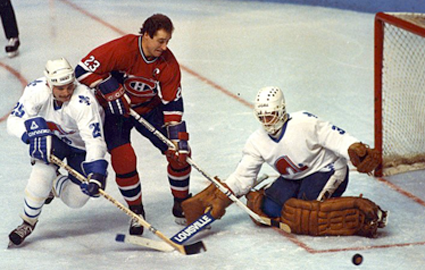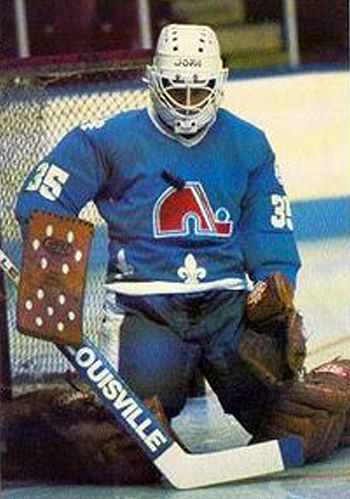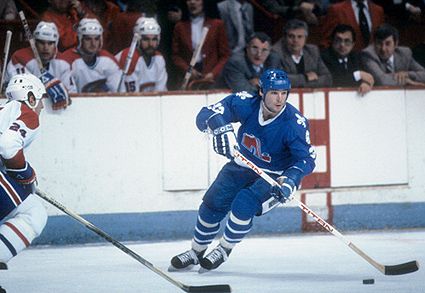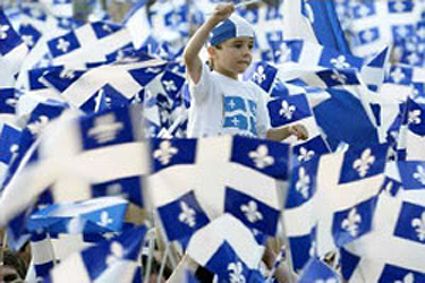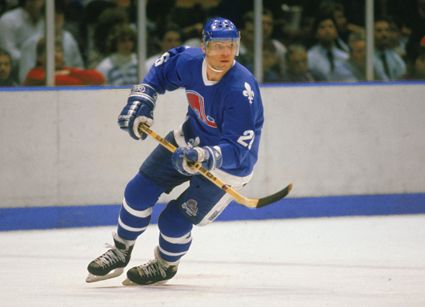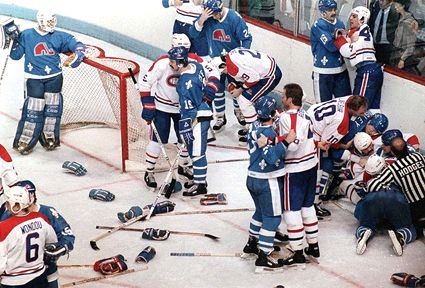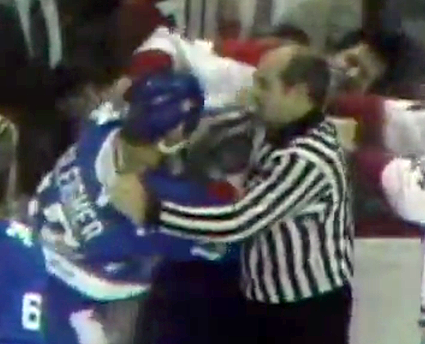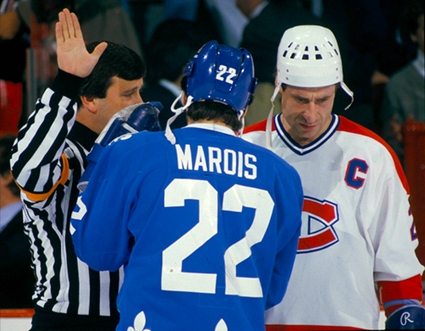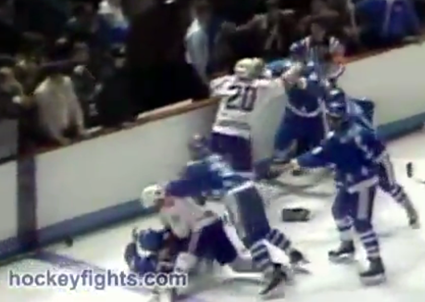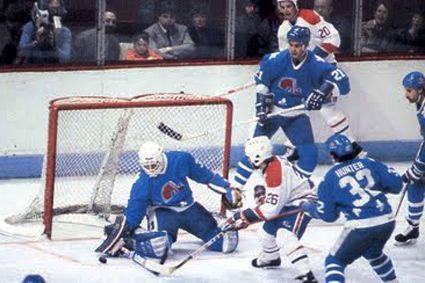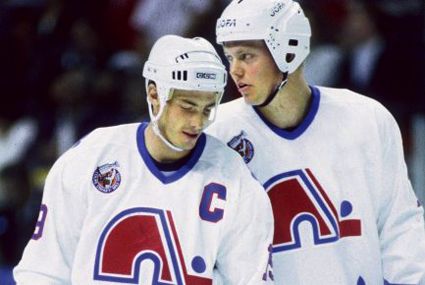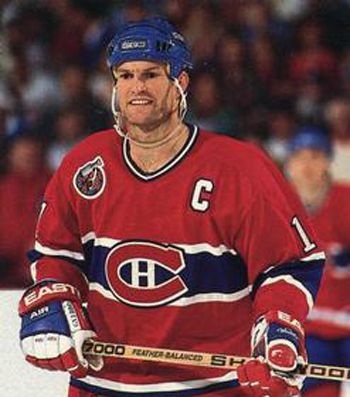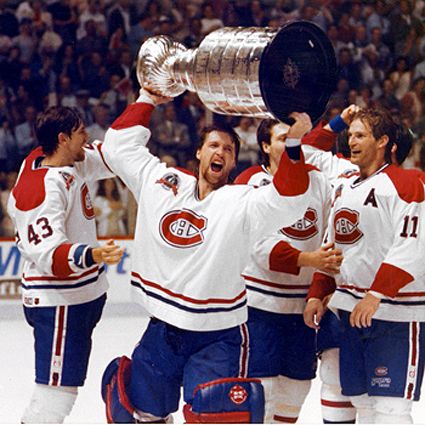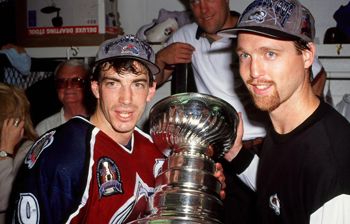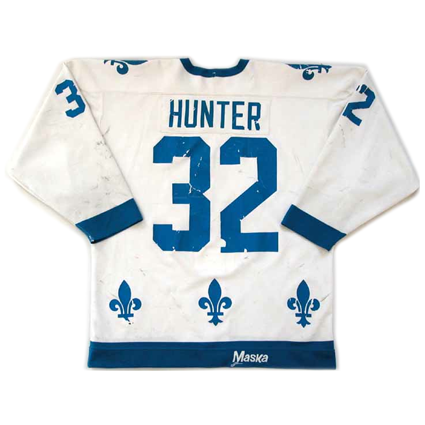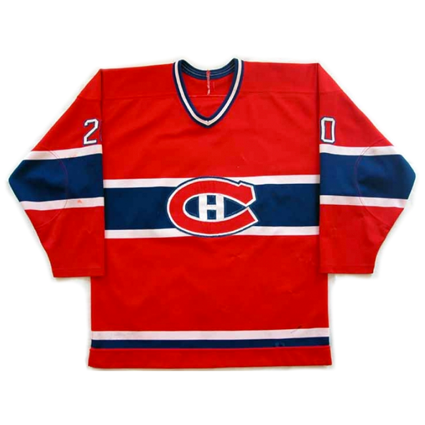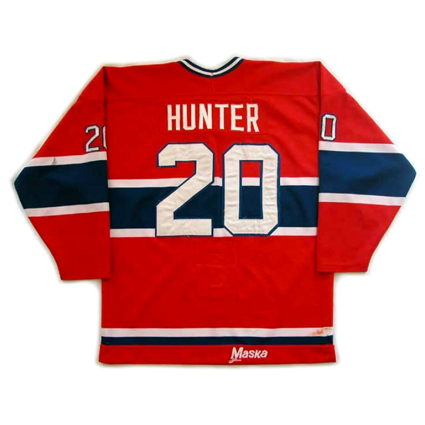After being returned to the minors, he was called up during the playoffs when Worsley was again hurt and was part of the Canadiens Stanley Cup winning team.
Saturday, April 23, 2016
1981-82 Chicago Black Hawks Tony Esposito Jersey
While not as numerous as the Sutters or Plagers, as flashy as the Bures, identical as the Sedins, offensively gifted as as a pair as the Richards, as highly paid as the Staals or as clandestine as the Stastnys, no other pair of brothers are as accomplished as the Esposito brothers.
Phil, the older by two years was a two time Stanley Cup champion, five time Art Ross Trophy, two time Hart Trophy, two time Lester Pearson Trophy and Lester Patrick Trophy winner. He was a 10 time NHL All-Star, had his #7 retired by the Boston Bruins and was inducted into the Hockey Hall of Fame in 1984. Phil retired as the second leading scorer in NHL history and holder of the single season goal scoring record with 76.
Tony Esposito, born on this date in 1943, was two years younger than Phil, played college hockey for Michigan Tech University where he was a three time All-American and backstopped the Huskies to the 1965 NCAA championship.
He first played in the NHL with the Montreal Canadiens when both Gump Worsely and Rogie Vachon were injured and saw action in 13 games, including giving up a pair of goals to his brother Phil during his very first game!
After being returned to the minors, he was called up during the playoffs when Worsley was again hurt and was part of the Canadiens Stanley Cup winning team.
Tony during his early days trying to crack the Canadiens linuep
After being returned to the minors, he was called up during the playoffs when Worsley was again hurt and was part of the Canadiens Stanley Cup winning team.
The Canadiens, deep in goaltending, left Esposito unprotected in the waiver draft, where he was claimed by the Chicago Black Hawks. He immediately set a modern NHL record with 15 shutouts, still an NHL rookie record, and a career high 38 wins on the way to being named the winner of the Calder Trophy as well as his first Vezina Trophy.
During his second season, he would guide the Black Hawks to the Stanley Cup Finals. The following season of 1971-72 saw Esposito earn his second Vezina Trophy on the basis of nine shutouts and a goals against average (GAA) of 1.77.
Prior to the start of the 1972-73 season, Esposito was named to Team Canada and was the first goalie to defeat the Soviet Union. He finished the Summit Series with a win in Game 2, a tie in Game 3, a loss in Game 5 and a victory in Game 7, as Team Canada, led offensively and emotionally by his brother Phil came back to defeat the Soviets 4-3-1 in the dramatic Game 8.
The Black Hawks, despite the departure of Bobby Hull to the WHA, returned to the Stanley Cup Finals in 1972 as Tony posted a 32-17-7 record, one of eight seasons with 30 wins or more.
1973-74 saw "Tony O" hit double digits in shutouts for the second time in his career with ten on his way to a 2.04 GAA and another Vezina Trophy, one of just eight goalies to win the Vezina catching right-handed.
Over the course of the next seven seasons, Esposito would continue his consistent play, appearing in between 66 and 69 games and winning between 24 and 31 times, as the Black Hawks won several division titles but failed to find playoff success.
In 1981, he became a naturalized American citizen and competed in goal for the United States in the 1981 Canada Cup.
The final three seasons of his career saw his number of games played decline from 52 to 39 to 18 in his final season of 1983-84, but he would record his sixth playoff shutout on this date, his birthday, in 1982 with a 2-0 win over rivals the St. Louis Blues.
Esposito, who originally wore #29 with Montreal, was the first NHL goalie to officially wear the #35, which was assigned to him in training camp due to the traditional goalie numbers 1 and 30 already being assigned. Following a shutout in his first ever exhibition game, he stuck with 35, making it an iconic number for goaltenders for decades to come.
Aside from becoming known for his #35, Esposito is also instantly recognized for his immediately recognizable goalie mask and stance. His mask would later have the addition of protective bars on the front, a precursor to today's hybrid mask worn by nearly all goaltenders at all levels.
Esposito retired in 1985 and was elected to the Hockey Hall of Fame in 1988 and saw his #35 retired by the Black Hawks later that same year.
Today's featured jersey is a 1981-82 Chicago Black Hawks Tony Esposito jersey as worn the year in which he recorded his final NHL playoff shutout. This jersey sports the now iconic #35, pioneered by Esposito and adopted by goaltenders all throughout the 1970's, 80's and 90's such as Tom Barasso, John Sebastian-Giguere, Nikolai Khabibulin (who originally wore #53 when he joined the Blackhawks), Henrik Lundqvist, Andy Moog, Evgeni Nabokov, Mike Richter, Tommy Salo, Tim Thomas and Marty Turco among many others.
Today's video section begins with a tribute to Tony Esposito by the Chicago Black Hawks from "Tony Esposito Night" in Chicago on March 19, 2008 as the Blackhawks honored Tony and welcomed him back into the Black Hawks family.
Here is the ceremony, in two parts, to honor Esposito on "Tony Esposito Night".
Labels:
Chicago Blackhawks,
Esposito Tony
Friday, April 22, 2016
1944-45 Toronto Maple Leafs Babe Pratt Jersey
During the 1944-45 NHL regular season, Maurice "Rocket" Richard broke Joe Malone's record for most goals in a season (44) on his way to becoming the first player to score 50 goals in an NHL season, which also established the standard of achieving 50 goals in 50 games, as the NHL schedule was then 50 games long.
Maurice Richard
Richard's teammate Elmer Lach won the scoring title with 26 goals and 54 assists for 80 points, with Richard coming in second with 73. Their linemate Toe Blake's 29 goals and 38 assists gave him 67 points, bettering the Boston Bruins Bill Cowley at 65, making it only the second time in league history that all three members of the same line finished 1-2-3 in scoring.
The Toronto Maple Leafs goaltender Frank McCool won the Calder Trophy as the league's top rookie, the third consecutive season the Calder Trophy winner came from the Maple Leafs following center Gus Bodnar in 1944 and right wing Gaye Stewart in 1943.
McCool with his Calder Trophy
Goaltender Bill Durnan of the Montreal Canadiens won the Vezina Trophy for the second consecutive season as the league's best goaltender, as his stellar 38-8-4 record gave him 14 more wins than McCool and the Detroit Red Wings Harry Lumley's 24 wins.
The final standings were clearly a case of the "haves" and "have nots", as Montreal easily led the league with 80 points, followed by Detroit with 67 and Toronto's 52. Boston qualified for the playoffs despite a poor 16-30-4 record, as their 36 points bested the Chicago Black Hawks 33 and the New York Rangers at 32.
For reasons we will never understand, the four playoff teams were not paired up with first place playing against fourth place and second place taking on third, but with the first overall club from the regular season hosting the third place finisher while the club finishing in second place drew the weakest qualifier from fourth place!
In the First Round of the playoffs, Toronto took the first two games in Montreal, with McCool outdueling Durnan in Game 1 to win 1-0 and following that with a 3-2 win. Montreal won Game 3 in Toronto 4-1 before Toronto put Montreal on the brink of elimination with a 4-3 win in overtime of Game 4 in Toronto.
The series moved back to Montreal for Game 5, where the Canadiens pounded the Maple Leafs 10-3, but the Maple Leafs rebounded back in front of the home fans to end their rivals season 3-2 to win the series in six games 4 games to 2.
In the other series, Boston gave Detroit all they could handle. The Bruins won the first two games in Detroit 4-3 and 4-2 before the Red Wings returned the favor and evened the series by winning twice in Boston by identical 3-2 scores. The series then completely switched form, as the home team won the remaining three games. First Detroit took a 3-2 lead in games with their third consecutive 3-2 victory, this one in overtime. Then Boston forced a deciding Game 7 with a 5-3 win at home, only to have Detroit return the favor with a series clinching 5-3 win of their own back at The Olympia.
The story of the 1945 Stanley Cup Finals was the defense. For the first time, two rookie goalies met in the finals, the 26 year old McCool and Detroit's Lumley, who was just 18 years old. McCool stonewalled the Red Wings in Game 1 at Detroit, which allowed the single Maple Leafs goal to stand, giving them a 1-0 victory.
Toronto managed two goals in Game 2, which turned out to be twice as many as they needed, as McCool again stymied Detroit on their home ice with his second consecutive shutout. Game 3 saw Lumley do just about all he could to keep the Red Wings in the game, but for the third consecutive game, McCool could not be solved and he put the Maple Leafs on the verge of a championship with yet another shutout by a score of 1-0, this time at Maple Leaf Gardens.
In Game 4 in Toronto, Detroit, who had gone 8-1-1 against Toronto during the regular season, finally solved McCool with a goal two minutes into the contest, proving to themselves that he was, in fact, human after all. Despite Teeder Kennedy's hat trick for Toronto, Detroit staved off elimination by a score of 5-3, doubling the total number of goals scored in the first three games combined.
Lumley now got on a roll and blanked Toronto back in Detroit in Game 5 by a 2-0 score before the dramatic Game 6 in Toronto. McCool and Lumley both kept clean sheets for 60 minutes and the contest entered overtime with both teams scoreless. Detroit not only stayed alive, but evened the series and denied the home fans a championship celebration when they won in overtime 1-0, giving Lumley his second consecutive shutout and the fifth one in the series six games.
The decisive Game 7 took place on this date in 1945 in Detroit with the Red Wings now on a roll, having come back from being down 3 games to none and having posted two consecutive shutouts. The game was tied at 1-1 with more than half the third period gone when defenseman Babe Pratt scored at 12:14 to give Toronto a lead McCool would protect to the end, giving the Toronto franchise it's fifth Stanley Cup championship.
The 1944-45 Stanley Cup Champion Toronto Maple Leafs
Toronto also became the first team to ever win Game 7 of the Stanley Cup Finals on the road, something that would not happen again until 1971 when the Canadiens won 3-2 in Chicago, and to date has only happened four times following the Pittsburgh Penguins in 2009 and Boston Bruins in 2011.
McCool would only play another 22 games in the NHL due to recurring health issues with ulcers, combined with the return of the Maple Leafs incumbent goaltender Turk Broda from his absence due to his military service during World War II. Broda had already been Toronto's starting goaltender for seven seasons and, following his return, manned the Maple Leafs net for another six seasons.
Pratt's goal was the first time in NHL history that a defenseman would score the cup winning goal, which seemed only fitting that a defenseman would win the cup seeing how defense ruled the day with five shutouts in the series' seven games.
Today's featured jersey is a 1944-45 Toronto Maple Leafs Babe Pratt jersey. This style of Toronto Maple Leafs jersey was first used in 1938 when the previous crest was replaced with this style. The lettering in the crest was changed to red for the next three seasons, before returning to this exact style with blue lettering in the crest, which would be retained through 1958.
This jersey would be revived as Toronto's choice as their Turn Back the Clock jersey for the NHL's 75th anniversary season in 1991-92. It was so well received that they redesigned their jerseys the following season to reintroduce this jerseys striping pattern and incorporate the crest as a retro style secondary shoulder patch paired with the continued use of their modern leaf as the main crest.
After being dropped in 2007 for a simpler jersey without the waist stripes for the introduction of the Reebok Edge jerseys, this basic pattern would return again this 2010-11 season with the addition of a lace up collar which was used on this jersey from 1958 to 1967.
Furthermore, a white version of this jersey would be first used in 1998-99 to commemorate the closing of their long time home, Maple Leaf Gardens. After a one year absence, the white throwback jersey would return as one of the, if not the finest alternate jerseys in league history.
Pratt would play eight seasons for the New York Rangers prior to joining the Maple Leafs for four seasons and the Boston Bruins for one. When the NHL portion of his career came to and end, Pratt would play five more seasons, mainly with the New Westminster Royals of the PCHL.
During his NHL career, Pratt would win the Stanley Cup twice, first in 1940 with the Rangers and then again with Toronto in 1945. Additionally, he would be named the winner of the Hart Trophy in 1944 as the NHL's most valuable player and inducted into the Hockey Hall of Fame in 1966.
He went on to work as both a TV analyst and goodwill ambassador for the Vancouver Canucks, who named the club's annual trophy for their best defenseman in his honor and wore a memorial patch in his memory on their jerseys after his passing at the arena during a game in 1988.
Oh. My. God.
Here, Pratt jokes with Harold Snepsts at a charity softball game in 1982 when shorts were short.
Really short.
We mean really, really unfortunately short.
Really short.
We mean really, really unfortunately short.
Here are the Canucks receiving their 2011 awards, including past winner of the award Snepsts, wearing thankfully longer pants this time around but a nearly as hideous retro jersey, presenting the Babe Pratt Award to Christian Ehrhoff.
Labels:
Pratt Babe,
Toronto Maple Leafs
Thursday, April 21, 2016
1950-51 Toronto Maple Leafs Bill Barilko Jersey
The Toronto Maple Leafs opened the 1950-51 season by going undefeated in their first 11 games, led by Al Rollins in goal. The Maple Leafs finished the 70 game schedule with a 41-16-13 mark and their .679 winning percentage remains a team record. Despite the record mark, the Maple Leafs actually finished second in the final regular season standings to the Detroit Red Wings, whose 44-13-13 record allowed them to finish 6 points ahead of Toronto to become the first team to ever reach 100 points in the standings with 101.
Max Bentley led the Maple Leafs in scoring with 21 goals and 41 assists for 62 points, followed by Teeder Kennedy's 61 points, Tod Sloan with 56 and Sid Smith's 51, as all four finished in the league's top ten scorers. Goltender Rollins 1.77 goals against average led the league and won him the 1951 Vezina Trophy.
Oddly, the playoff matchups for the semi-finals saw the #1 Detroit Red Wings paired off against the #3 Montreal Canadiens. That left the #2 Maple Leafs to play the #4 Boston Bruins. Montreal upset Detroit 4 games to 2 and Toronto earned their place in the finals by eliminating the Bruins 4 games to 1.
Game 1 in Toronto went to overtime as the Maple Leafs prevailed by a score of 3-2. The Canadiens evened the series heading back to Montreal with an identical 3-2 victory in Game 2, which also went to overtime.
The Maple Leafs spoiled the Canadiens homecoming in Game 3 with a narrow 2-1 win, which required yet another extra period after the clubs were tied after regulation for the third straight game. Toronto put themselves in the driver's seat in Game 4 with their second win in Montreal by a score of 3-2, this one yet again requiring an extra period after the teams were tied at the end of regulation.
Game 5 took place on this day in 1951 at Maple Leaf Gardens in Toronto. Just when it looked like a game would be settled in regulation, the Maple Leafs Sloan evened the score with his second goal of the game with just 32 seconds remaining with Toronto's goaltender Rollins on the bench for an extra attacker to force overtime for the fifth consecutive game.
The overtime took two minutes and 53 seconds as Bill Barilko, a defenseman, moved in from the point and launched himself at the puck, sending it flying over Canadiens goaltender Gerry McNeil as he fell to the ice.
Barilko's goal is considered to be by many the most famous goal in the long history of the Maple Leafs, ending what has become known as the "Sudden Death Series", as each one of the five games required overtime.
Barilko scoring his famous Stanley Cup winning overtime goal
Barilko's goal is considered to be by many the most famous goal in the long history of the Maple Leafs, ending what has become known as the "Sudden Death Series", as each one of the five games required overtime.
It would be the final goal Barilko would ever score.
Four months later the 24 year old Barilko and his dentist Henry Hudson would board Hudson's plane headed for Seal River, Quebec on a fishing trip and never return. The plane went down on the flight home and remained undiscovered for eleven years before being found 35 miles off course. The cause of the crash was determined to have been a combination of pilot inexperience, poor weather and overloaded cargo.
After winning the Stanley Cup four times in the previous five years, the Maple Leafs would not win another Stanley Cup while Barilko was missing. They would finally win the Cup again in 1962, the year Barilko was finally found six weeks after the Maple Leafs won the cup.
1950-51 Stanley Cup Champion Toronto Maple Leafs
Barilko's story was chronicled in the song "Fifty Mission Cap" by the Canadian band The Tragically Hip in 1992.
Barilko's #5 is one of only two numbers officially retired by the Toronto Maple Leafs.
Today's featured jersey is a 1950-51 Toronto Maple Leafs Bill Barilko jersey, the one he wore when he scored one of the most famous goals in Maple Leafs history, the overtime game winner of the 1951 Stanley Cup Finals.
This jersey is on display at the Hockey Hall of Fame in Toronto, Ontario, Canada. This style jersey was worn by the Maple Leafs from 1938 to 1958.
This jersey is on display at the Hockey Hall of Fame in Toronto, Ontario, Canada. This style jersey was worn by the Maple Leafs from 1938 to 1958.
Labels:
Barilko Bill,
Toronto Maple Leafs
Wednesday, April 20, 2016
La Bataille du Québec 1979-1995 - The Montreal Canadiens vs. the Quebec Nordiques
Since the demise of the anglophone Montreal Maroons in 1938, the Montreal Canadiens had the French speaking province of Quebec all to themselves for 41 seasons until the 1979 NHL expansion which admitted the four surviving members of the World Hockey Association, one of which was the Quebec Nordiques, who were based out of Quebec City, located 145 miles to the northeast of Montreal.
The rivalry started before play even began when the Canadiens were one of five NHL clubs to vote no on the proposal to include the WHA teams in the NHL. However, the owner of the Canadiens, Molson Breweries feared a boycott of their product by not only the citizens of Quebec, one of whom called in a bomb threat to the Molson brewery in Quebec City after the no vote, but also in both Edmonton and Winnipeg, the other two Canadian cities with WHA clubs affected by proposed expansion.
Proof that fans were upset with the Canadiens no vote came in sales of a mere 100 bottles of Molson at the next Jets game in Winnipeg, when they would normally sell 2,500 bottles. Signs appeared in the affected team's arenas which read "Molson's Don't Want Us. We Don't Want Molson's". The Canadiens eventually voted for the expansion, but were able to win a provision that the Nordiques would not receive a share of national television revenue for five years. "Our primary consideration in changing our vote was selling beer," Montreal president Jacques Courtois said at the time.
Proof that fans were upset with the Canadiens no vote came in sales of a mere 100 bottles of Molson at the next Jets game in Winnipeg, when they would normally sell 2,500 bottles. Signs appeared in the affected team's arenas which read "Molson's Don't Want Us. We Don't Want Molson's". The Canadiens eventually voted for the expansion, but were able to win a provision that the Nordiques would not receive a share of national television revenue for five years. "Our primary consideration in changing our vote was selling beer," Montreal president Jacques Courtois said at the time.
At first, the two teams were placed in separate divisions, with Montreal in the Norris and Quebec in the Adams, which limited the intensity of the rivalry. The two teams met for the first time on October 13, 1979, which was won by the host Canadiens 3-1. Their first meeting in Quebec City came a little over two weeks later, which was won by the Nordiques in upset fashion 5-4.
Over the Nordiques first two seasons in the NHL Montreal held a slight edge at 3-2-3 with each team holding serve at home.
A rivalry was born with the Nordiques entered the NHL in 1979
One factor in the rivalry between the two clubs was that, while Quebec City was the capital of the province, Montreal was a much larger, more cosmopolitan city with a population four to five times that of Quebec. With the Nordiques now in the NHL, it was the first time Quebec City felt it could compete head to head with Montreal at any level.
The rivalry intensified in 1981-82 when the NHL realigned along geographical lines, which saw Montreal now placed in the Adams Division with the Nordiques. Along with the change in divisions, the schedule was also altered. The old system saw each club play every other team four times and the first place team in the regular season was matched with the 16th and last team to qualify for the playoffs without regard for conferences. Now, the new format called for each team to play the other clubs in their division eight times and the first two rounds of the playoffs would now take place entirely within the division.
The 1981-82 season series between the Canadiens and Nordiques saw the teams tie at 3-3-2 with Montreal taking a win in Quebec City, the first time either team was able to secure a victory on the road.
Montreal would win the Adams Division with a 46-17-17 record for 109 points, while Quebec (33-31-16, 82 points) finished fourth behind the Boston Bruins and Buffalo Sabres to set up a first round playoff matchup with the heavily favored Canadiens.
Game 1 went to the Canadiens 5-1, who outshot the Nordiques by a whopping 41-19. Game 2 was tied 2-2 after two periods but Dan Bouchard shut down the Canadiens while Pierre Aubry's goal at 2:30 in the third held up as the game winner for the Nordiques to even the best-of-five series 1-1 as the Nordiques took away a vital 3-2 win on the road, their first ever win in Montreal.
With the series now shifted to Quebec City, the Nordiques got two goals within 1:12 of each other late in the first period, which held up for a 2-1 win for the underdogs. The rivalry really arrived in Game 4 when a huge bench clearing brawl erupted at the 9:20 mark of the first period which resulted in 154 penalty minutes from 2 minors, 4 majors, 11 misconducts and 2 game misconducts. On the scoreboard, it was all Montreal as they cruised to a 6-2 win, forcing a decisive Game 5 back in Montreal.
The Nordiques struck first with a goal at 4:40 of the first period and added a power play goal at 14:49. Their two goal lead held up through the midway point of the third period when the Canadiens began their comeback with a goal at 10:49 and the equalizer arrived at 12:14 to the delight of the home fans. Bouchard again held off the Canadiens through the remainder of regulation as the shots on goal for the first 60 minutes heavily favored Montreal, 35-18.
If we didn't have a rivalry before, we had one now as the hated Dale Hunter scored the winning goal just 22 seconds into overtime as the Nordiques eliminated Montreal despite finishing 27 points behind them in the regular season standings, kicking "The Battle of Quebec" into a new level of intensity that can only come from the playoffs.
Dale Hunter scored the goal that eliminated Montreal in 1982,
igniting the already simmering rivalry between the two clubs
After Hunter's goal, beer sales in the province dropped by 9.2% as fans avoided products sold by the owner of their rival franchise, as the Canadiens were owned by Canada's second largest brewer Molson, while the Nordiques were controlled by the third largest, Carling O'Keefe. The rivalry also affected beer sales the other way as well, as during the first 10 years Carling O'Keefe owned the Noriques, their share of sales in the province rose from 25% to 32%.
Yet another factor in the rivalry was the intense coverage by the French press, which often featured page after page of hype in advance of games, followed by even more ink following the games which featured many quotes which would be scrutinized and magnified, often later ending up on the blackboard in the opposing locker room before the next game.
Montreal won the 1982-83 season series 5-2-1 while the Nordiques took the 1983-84 series 5-3. During the playoffs 4th place Montreal upset the Boston Bruins while the 3rd place Nordiques did the same to the Buffalo Sabres, setting up the second playoff series between the two clubs.
The political situation in Quebec at the time was also one of great debate and passion, as there was a strong movement for Quebec to break away from the rest of English-speaking Canada, and the Canadiens came to be seen as the team favored by those who were against the idea of separation, while the Nordiques, whose jerseys proudly were reflective of the flag of Quebec and it's light blue color and fleur-de-lis, came to be seen as a symbol of Quebec's independence.
The independence movement in Quebec
added even more passion to the rivalry
added even more passion to the rivalry
Game 1 went to the home Nordiques 4-2, which saw 4 major penalties and 2 misconducts. Montreal turned the tables the next night with three goals in the final 12 minutes of the game to turn a 1-1 nailbiter into an easy 4-1 triumph.
The third game in Montreal went the way of the Canadiens 2-1 while Game 4 saw the Nordiques fight back from a 3-1 deficit late in the second period to send the game into overtime, which they won with Bo Berglund's goal 3:00 into overtime to tie the series at 2-2.
Game 5 in Quebec City was a 4-0 blanking for Montreal, who now put the Nordiques on the brink of elimination, down 3 games to 2.
The 6th game was back at the Forum in Montreal on this date in 1984 and the tone was set early with George McPhee and Wilf Paiement each receiving fighting majors just 23 seconds into the game. Bobby Smith and Michel Goulet were sent off next with matching minors at 2:48. Craig Ludwing's minor for Montreal at 4:18 was followed by Jean Hamel's at 5:01, giving the Nordiques a 5-on-3 advantage, which led to Peter Stastny's powerplay goal for the Nordiques at 5:12. Chris Nilan and Pat Price later were sent off together at 17:23 of the first as the pot continued to simmer.
There was no scoring in the second period and more than fifteen minutes of it passed with only a single minor to Goulet at 3:52. Then Chris Chelios and Hunter were sent off at 15:20. After Hunter returned, he and Rick Green of Montreal were whistled for minors at 17:39. Just 20 seconds after play resumed, Ludwig and Anton Stastny fought and received fighting majors. The feistiness continued with Andre Dore getting a minor at 19:44 followed by Smith for Montreal just four seconds after play resumed.
When the final whistle for the period blew with the puck in front of the Quebec goal, Hunter crosschecked Guy Carbonneau to the ice and fell on top of him. As one of Carbonneau's teammates came to his aid, other Nordiques came over to make sure things were even while both benches emptied as the period was over. As the scrum in start of the net began to boil over, punches began to fly when Montreal's Nilan sucker punched Randy Moller of the Nordiques, which set off a huge brawl and enraged Moller. Players paired off with no less than 14 fights breaking out, including one between the backup goaltenders Richard Sevigny and Clint Malarchuk!
After three minutes things died down with Hamel down and bloody on the ice after being nailed by Louie Sleigher. This was the end of the fracas and the teams departed for their locker rooms for the second intermission.
Louie Sleigher sucker punches Jean Hamel
While during the break, the Canadiens players were able to learn the details of the sucker punch which laid out Hamel and they came out before the start of the next period with revenge on their minds, and in those days players could go on the ice before the period and get in a little warmup skate, not simply coming out onto the bench like it's done today.
Referee Bruce Hood explaining the penalties to captains Bob Gainey and Mario Marois as trouble was brewing elsewhere on the ice
Sleigher, who had been given a game misconduct for his role in the fighting at the end of the second period but had not been informed yet(!), along with several other players who should not have even been allowed on the ice (troublemaker Nilan in particular) for the start of the third period, was sought out by the Canadiens before the puck was even dropped, only this time the Nordiques Dale Hunter, who missed out on much of the first brawl having left the ice after his part in the fight at the end of the period, was now on the ice and he was eventually engaged by none other than Canadiens goaltender Sevigny!
Calm had seemingly returned at one point after a few brief battles until Montreal's Mark Hunter (Dale's brother) persisted in going after Sleigher and when Dale Hunter tried to stop Mark Hunter, Dale Hunter was grabbed by Mario Tremblay, who was jumped from behind by Andre Dore, setting off another round of fury, which included Rick LaPointe and Chelios leaping into the fray and Mark and Dale Hunter even fighting each other, all the while the Forum P. A. Announcer was reading off the penalties from the battle at the end of the second period! The entire affair was dubbed "The Good Friday Massacre" with over 250 penalty minutes being handed out during the game.
The flash point when Dore jumped on Tremblay who had tackled Dale Hunter, while Mark Hunter #20 went after Sliegher
"The rivalry back then was like a balloon that inflated a little more each game and then on that night, the balloon finally popped. It's been over 25 years and we're still talking bout that incident like it was three months ago," said Sevigny in 2010.
Once play resumed, Quebec scored at 2:02 to take a 2-0 lead, only to have the inspired Canadiens come storming back with five straight goals in eight minutes to eventually win the game 5-3 and eliminate the favored Nordiques 4 games to 2, triggering a celebration in the streets of Montreal which lasted until 3 AM, said to be larger than the last time the Canadiens had won the Stanley Cup!
The following season Montreal dominated 6-1-1 and the teams met in the playoffs for the third time in four seasons. It was a back and fourth series, with the Nordiques winning Game 1 in overtime in Montreal. The Canadiens won Game 2 by a score of 6-4. It was the Nordiques turn to win at home in overtime of Game 3 in a wild 7-6 affair. Montreal won 3-1 in Quebec City to even the series at 2-2. The teams then traded road wins with the Nordiques winning 5-1 before Montreal forced a Game 7 with their 5-2 win in Quebec City. The pattern continued in the decisive game, as it was now the Nordiques turn to win, which they did with Peter Stastny's goal at 2:22 of overtime eliminating the Canadiens in Montreal, the fifth road win and third overtime game of the hotly contested series.
The Canadiens and Nordiques met for the third time in four years in 1985
The two clubs did not meet in the 1986 playoffs after Quebec dominated the regular season 6-2, only to see the Canadiens capture the Stanley Cup after the Nordiques were eliminated in the first round by the Whalers.
In 1986-87, the playoffs loomed once again, as the two intense rivals were to meet in the second round. The Nordiques won Games 1 and 2 in Montreal (7-5 and 2-1) only to have Montreal do the same at Le Colisee in Quebec City (7-2 and 3-2), with Game 4 being decided in overtime and featuring a pregame fight between Basil McRae and Sergio Momesso. From then on the games all belonged to the home teams, with Montreal winning Game 5 (aided by a go ahead goal for Quebec by Alain Cote being waved off which caused Nordiques coach Michel Bergeron to declare that the game had been "stolen" from them) and Quebec taking Game 6 by identical 3-2 scores. Montreal then won the series with five goals in the second period of Game 7 to win 5-3 and end the Nordiques season and tie their all-time playoff meetings at two wins apiece.
The Nordiques spoiled the party by failing to qualify for the postseason for the next five seasons as they sank to the depths of the standings, finishing dead last in 1989, 1990 and 1991 as well as 21st out of 22 in 1992.
All the high draft picks the Nordiques accumulated during their wandering the hockey desert began to pay off in 1992-93 when they once again qualified for the playoffs with a strong 47-27-10 mark for 104 points, two better than the Canadiens. Thanks to the inter-divisional playoff format, two of the top six teams in the league were forced to play each other in a titanic opening round series, the fifth meeting in "La Bataille du Québec". The Nordiques entered the playoffs with an entirely new roster that the previous time the two clubs met. Gone were Goulet, the Stastny brothers, Hunter, Cote and Malarchuk and in were Mats Sundin, Joe Sakic, Mike Ricci, Owen Nolan, Valeri Kamensky and goaltender Ron Hextall, many of whom were experiencing the playoffs for the very first time.
Quebec won Games 1 and 2 at home, 3-2 in overtime and 4-1 to give the upstarts hope that victory was possible only to have the Canadiens win Games 3 and 4 at home, with the third one coming in overtime. Back in Quebec, Montreal led Game 5 with the only goal of the first period only to have the Nordiques fight back with a pair of goals to take the lead. The Canadiens added a pair to surge back in front before Nolan and Sundin put Quebec back in front once again! Montreal was able to get the equalizer to force another overtime and Kirk Muller disappointed the home fans with the game winner at 8:17 from Vincent Damphousse and Eric Desjardins, who had each scored a goal in Montreal's first comeback in the second period.
Game 6 back in Montreal saw the Canadiens go up by two but once more the resilient Nordiques battled back to tie the game with two goals in less than five minutes early in the second period. The Canadiens were not rattled though, as they added a pair of their own before the period was over and Patrick Roy in goal shut down Quebec the rest of the way as Montreal pulled away with two more goals in the third period to win the series on their way to an eventual Stanley Cup championship later that spring.
since the arrival of the Nordiques in the NHL in 1979
The Nordiques missed the playoffs the following season and Montreal did not qualify in 1995, bringing to an end their legendary rivalry as the Nordiques dire financial situation would lead to them being sold to interests in the United States who would relocate the team to Denver, Colorado, ending their 23 years in Quebec City and their 16 year battle with the Canadiens.
"The rivalry was extraordinary," said Carbonneau, a former Canadiens captain and coach. "We lived the hatred on the ice."
Thanks to the Nordiques dismal period in the early 1990's, Montreal won the all-time series 62-39-12, but of the five times the teams met in the playoffs, one series went the full five games, two six and two the full seven for a total of 31 games out of a possible 33, with Montreal holding a narrow edge in games 17-14 with the Canadiens winning three series to the Nordiques two, and each team pulling off upsets of the other in one of the most intense rivalries the NHL has ever seen.
While the rivalry was ongoing, Montreal would win a pair of Stanley Cups, only adding to Quebec City's frustration with and inferiority complex because of Montreal, as the Nordiques would never reach the finals. Salt was rubbed into the wound when the relocated Nordiques, now renamed the Avalanche, would immediately win the Stanley Cup in their first try after moving with the nucleus of players drafted by the Nordiques, plus quite ironically, the addition of the despised former Canadiens goaltending superstar Roy who put the club over the top.
for the former Nordiques the very first season after they left Quebec
Today's featured jersey is a 1981-82 Quebec Nordiques Dale Hunter jersey. The Nordiques wore the same jerseys throughout their entire run in the NHL, with the only adjustments being using brands Sandow SK, Maska and CCM. The Nordiques were the last team to use heat sealed numbers prior to changing to sewn on twill in 1991-92 when red trim was added to the previously single color numbers for both their home and road jerseys. Note the condition of the back numbers on today's featured jersey's heat sealed numbers.
Patches worn by the Nordiques were the Canada Games patch in 1982-83, Rendez Vous '87 in 1986-87 and the league wide NHL 75th Anniversary patch in 1991-92 and the Stanley Cup Centennial patch in 1992-93, which was produced in a special French version for the Nordiques and Canadiens, which read "Coupe Stanley".
Dale Hunter had a 19 year NHL career, the first seven with the Nordiques and then 12 with the Washington Capitals before closing out his career with a dozen games with the Avalanche. He scored 323 career goals and 1,020 points as well as 3,565 penalty minutes.
Today's other featured jersey is a 1982-83 Montreal Canadiens Mark Hunter jersey. An unchanging icon of hockey jerseys, the Canadiens classic red sweaters date back to 1912-13, four years before the formation of the NHL.
Mark Hunter played 12 NHL seasons, including four with the Canadiens during their rivalry with the Nordiques, which famously included his fight on this date in 1984 with his brother Dale. He would subsequently play for the St. Louis Blues, Calgary Flames, Hartford Whalers and Washington Capitals while amassing 1,426 career penalty minutes.
Today's video section begins with the first outbreak of fighting at the end of the second period, which includes Hamel being sucker punched by Sleigher and continues with the players fighting again when they come out to start the third period, which includes the Hunter brothers throwing punches at each other!
For an 11 minute CBC Radio story on the rivalry focusing one the cultural differences between the two clubs, click here.
Labels:
Hunter Dale,
Hunter Mark,
Montreal Canadiens,
Quebec Nordiques
Tuesday, April 19, 2016
1972-73 New England Whalers Rick Ley Jersey
The New England Whalers were born in November of 1971 when the new World Hockey Association (WHA) awarded a franchise to a group of four businessmen to be located not in their eventual home of Hartford, Connecticut, but originally in Boston, Massachusetts.
Additionally, the Whalers signed veteran Ted Green away from the Bruins to be the team's first captain.
The Whalers were forced to be creative in assembling their roster, as 12 WHA teams were seeking to employ roughly 275
professional players in all. Additionally, the NHL had also expanded by
two clubs that season in an attempt to occupy markets the WHA might have
found attractive, placing clubs on Long Island in New York and Atlanta,
Georgia, meaning in actuality, approximately 325 more players would be needed to
stock an additional 14 combined rosters than the season before.
The
tactic taken by the Whalers was to embrace the often overlooked
American player, signing former US Olympic Hockey Team members,
particularly those with ties to Boston. Larry Pleau, a Boston native, was lured away from the Montreal Canadiens on this date in 1972 to become the first player signed by the fledgling franchise.
To stock their roster for the inaugural WHA season, Kevin Ahearn, John Cunniff, Paul Hurley and Tim Sheehy, who all played for the Boston College Eagles, and Tommy Williams, who had played for the NHL's Boston Bruins, were all recruited to join the Whalers inaugural roster.
as Pleau becomes the first player signed by New England
To stock their roster for the inaugural WHA season, Kevin Ahearn, John Cunniff, Paul Hurley and Tim Sheehy, who all played for the Boston College Eagles, and Tommy Williams, who had played for the NHL's Boston Bruins, were all recruited to join the Whalers inaugural roster.
Additionally, the Whalers signed veteran Ted Green away from the Bruins to be the team's first captain.
Coach Jack Kelley and team captain Ted Green
They also lured 30 goal scorer Tom Webster away from the California Golden Seals, whose owner Charlie O. Finley refused to open the checkbook to keep several of his better players when the WHA came to raid his roster.
Rick Ley of the Toronto Maple Leafs was called upon to anchor the team's defense in front of former Pittsburgh Penguins and Detroit Red Wings goaltender Al Smith, who would eventually serve two terms with the Whalers.
Jack Kelley, who had just won back to back national titles with Boston University in 1971 and 1972, was hired to coach the team. Additionally, Canadians John Danby and Ric Jordan, both of whom were members of Kelley's national championship winning Terriers, joined the Whalers along with their head coach.
The Whalers began play located in Boston, dividing their home games between the Boston Arena and the Boston Garden, the home of the Bruins since 1928. The Boston Arena, which opened in 1910, is the oldest ice hockey arena still in use and was the Bruins original home and is still being used by the Northeastern University Huskies of Hockey East, although it was renamed Matthews Arena in 1982.
The ceremonial opening faceoff between captain Ted Green and
Philadelphia's Derek Sanderson at the Whalers first ever game.
Note the Bruins logo prominent at center ice!
Philadelphia's Derek Sanderson at the Whalers first ever game.
Note the Bruins logo prominent at center ice!
The inaugural Whalers season went better than anyone could have hoped for, as the Whalers won their first three games and nine of their first 13. They also posted a six game winning streak in early December to go ten games over .500.
First signee Pleau scores the game winning goal against
#00 Bernie Parent of Philadelphia during the Whalers first game
The Whalers finished the season strong with an eight game winning streak in early March, which included scoring seven goals in back to back games against the Winnipeg Jets and Minnesota Fighting Saints. The team finished with a 46-30-2 record for 94 points, best in the league. At the conclusion of the season, Whalers forward Terry Caffery was named the league's Rookie of the Year following his 29 goal, 100 point season.
WHA Rookie of the Year Terry Caffrey battles for the puck
In the playoffs, the Whalers defeated the Ottawa Nationals, who actually moved their playoff games to Toronto in advance of relocating there the next season, such was life in the rest of the WHA. The Whalers then ousted the Cleveland Crusaders and then defeated the Winnipeg Jets (all by identical 4 games to 1 totals) to capture the Avco World Trophy as the WHA's inaugural champions.
In typical WHA fashion, fans in Boston not in attendance were unable to see the celebration, as the local TV station pulled the plug on the game with seven minutes remaining in order to begin broadcasting a tennis match! If that were not enough, the Avco World Trophy was not actually completed yet, and the team had to skate around the rink with their Eastern Conference Championship cup as a substitute!
Green celebrates with the substitute trophy following the Whalers victory
The club was led in scoring by Webster, who set career highs in goals, assists and points, with 53 goals, 50 assists and 103 points to place fourth in the WHA scoring race. Caffery's 100 points were good for second on the club, while Pleau was next with his 39 goals and 87 points. Smith recorded 31 wins in goal.
The WHA champion 1972-73 New England Whalers
Immediately after winning the championship, the Whalers owner Howard Baldwin issued a challenge to the eventual NHL champion to meet in a one-game playoff on neutral ice for the rights to the Stanley Cup! Needless to say, the NHL did its best to ignore the upstart league for fear of giving it any credibility, and the game never came close to taking place.
The Whalers championship banner
The following season the Whalers again won the Eastern Division with a 43-31-4 record for 90 points, good for a second place tie in overall points.
Rick Ley in the Whalers second jerseys
Winger John French led the team in scoring with 72 points, while Webster led the team in goals in 43, fourth most in the league. Smith again reached the 30 win level in the nets for the Whalers.
The postseason did not go as planned, as the Whalers ran into a tough Chicago Cougars club, who had finish nine points back in the standings. The Whalers took Game 1 and 2 at home in Boston, but dropped the next two in Chicago. After Chicago took Game 5 in Boston, the Whalers avoided elimination with a 2-0 win back in Chicago to force a Game 7 back at home, only to fall short 3-2, bringing their season to an end.
By now, scheduling games in the Boston Garden had become increasingly difficult, as the Boston Celtics of the NBA were also in need of dates. Team ownership put a plan in place to relocate the club 100 miles west to Hartford, Connecticut, but the new Hartford Civic Center would not be ready for the start of the season, causing the Whalers to play in Springfield, Massachusetts at the Springfield Coliseum from October, 1974 until their debut in Hartford on January 11, 1975, bringing to and end their time of calling Massachusetts home.
The Whalers were 21-15-2 in their temporary location despite a schedule heavily loaded with road games, playing 25 out of their first 38 away from Springfield, including road trips of 6 and 7 consecutive games. The Whalers finished the season 43-30-5 to win their third consecutive Eastern Division title, at one point playing ten consecutive home games during a stretch of 17 out of 20 at their new home in Hartford.
The WHA lasted until the 1978-79 season, after which the Whalers and three other WHA clubs were allowed into the NHL as expansion clubs - not a merger of leagues. One of the conditions of the Whalers being granted entry into the NHL was they were forced to change their name from the New England Whalers to the Hartford Whalers at the demand of the very same Bruins they briefly shared a home rink with.
Today's featured jersey is a 1972-73 New England Whalers Rick Ley jersey. This style of Whalers jersey was worn only for their inaugural, championship winning season in Boston. What made it distinctive was it's circular crest, trimmed with a rope pattern and containing the team name in the circle. A popular feature of the jersey was the secondary shoulder logo, Pucky the Whale. Ley's #2 is one of only three numbers ever retired by the Whalers.
Bonus Jersey: Today's bonus jersey is a 1972-73 New England Whalers Brit Selby jersey as worn at home during the team's inaugural season in Boston. The Whalers simplified their crest to something more modern and graphic for their second season, taking the "W" from their original round logo with a simplified harpoon bisecting it.
Selby broke into the NHL during the 1964-65 season with the Toronto Maple Leafs, playing in 3 games. He played in 61 games the following season of 1965-66, scoring 14 goals and 27 points and was named the recipient of the Calder Trophy as the NHL's Rookie of the Year. His 1966-67 season was an abbreviated one, playing in just 6 games for the Maple Leafs and 15 for the minor league Vancouver Canucks of the Western Hockey League. He joined the Philadelphia Flyers for their first season of 1967-68. In his second season with the Flyers, Selby was involved in a trade which sent him back to Toronto where he would play for parts of three seasons. After 11 games of the 1970-71 season, he was on the move again, this time to the St. Louis Blues. His second season with the Blues was spent primarily with the Kansas City Blues of the Central Hockey League.
With the expansion of jobs for the 1972-73 season with the arrival of the WHA, Selby took the opportunity to escape the minors after he was selected by the Houston Aeros of the WHA. A series of trades saw him first play for the Quebec Nordiques for 7 games before landing with the Whalers, where he would play in 65 games, scoring 13 goals and 42 points during their inaugural, championship season. He spent the final two years of his career with the Toronto Toros of the WHA.
Selby broke into the NHL during the 1964-65 season with the Toronto Maple Leafs, playing in 3 games. He played in 61 games the following season of 1965-66, scoring 14 goals and 27 points and was named the recipient of the Calder Trophy as the NHL's Rookie of the Year. His 1966-67 season was an abbreviated one, playing in just 6 games for the Maple Leafs and 15 for the minor league Vancouver Canucks of the Western Hockey League. He joined the Philadelphia Flyers for their first season of 1967-68. In his second season with the Flyers, Selby was involved in a trade which sent him back to Toronto where he would play for parts of three seasons. After 11 games of the 1970-71 season, he was on the move again, this time to the St. Louis Blues. His second season with the Blues was spent primarily with the Kansas City Blues of the Central Hockey League.
With the expansion of jobs for the 1972-73 season with the arrival of the WHA, Selby took the opportunity to escape the minors after he was selected by the Houston Aeros of the WHA. A series of trades saw him first play for the Quebec Nordiques for 7 games before landing with the Whalers, where he would play in 65 games, scoring 13 goals and 42 points during their inaugural, championship season. He spent the final two years of his career with the Toronto Toros of the WHA.
photo courtesy of Classic Auctions
Extra bonus jersey Today's extra bonus jersey is a 1976 United States National Team Larry Pleau jersey as worn during the 1976 Canada Cup tournament. Highlighting the Whalers tendencies in assembling their original roster towards United States Olympians and players with ties to Boston, Pleau, a Boston native, competed for the United States at the 1968 Olympics and 1969 World Championships before being signed by the Whalers.
The original set of these striking, patriotic United States jersey worn the year of the American Bicentennial were all sewn on customization, heavy weight jerseys, which the players deemed too hot to wear. This jersey is from the second set made for the actual tournament competition, which were cooler mesh jerseys with all the graphics screened on, an inferior quality jersey, but one which was more suited to competition.
Our video section today kicks off with a profile of Ley, the longtime Whalers defenseman.
The original set of these striking, patriotic United States jersey worn the year of the American Bicentennial were all sewn on customization, heavy weight jerseys, which the players deemed too hot to wear. This jersey is from the second set made for the actual tournament competition, which were cooler mesh jerseys with all the graphics screened on, an inferior quality jersey, but one which was more suited to competition.
photo courtesy of Classic Auctions
Finally, a look at the Whalers inaugural season in five brief parts which total about 20 minutes.
Labels:
New England Whalers,
WHA
Subscribe to:
Comments (Atom)

